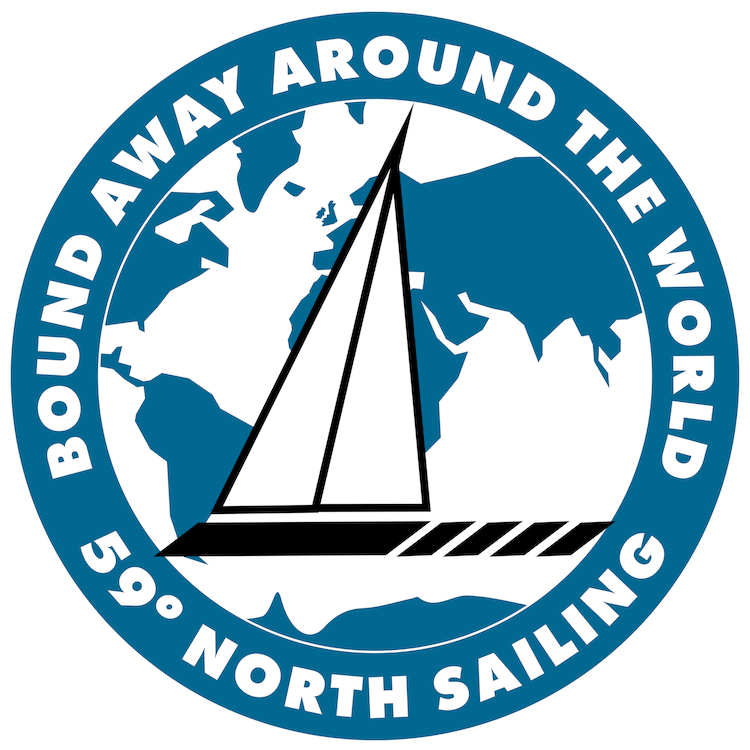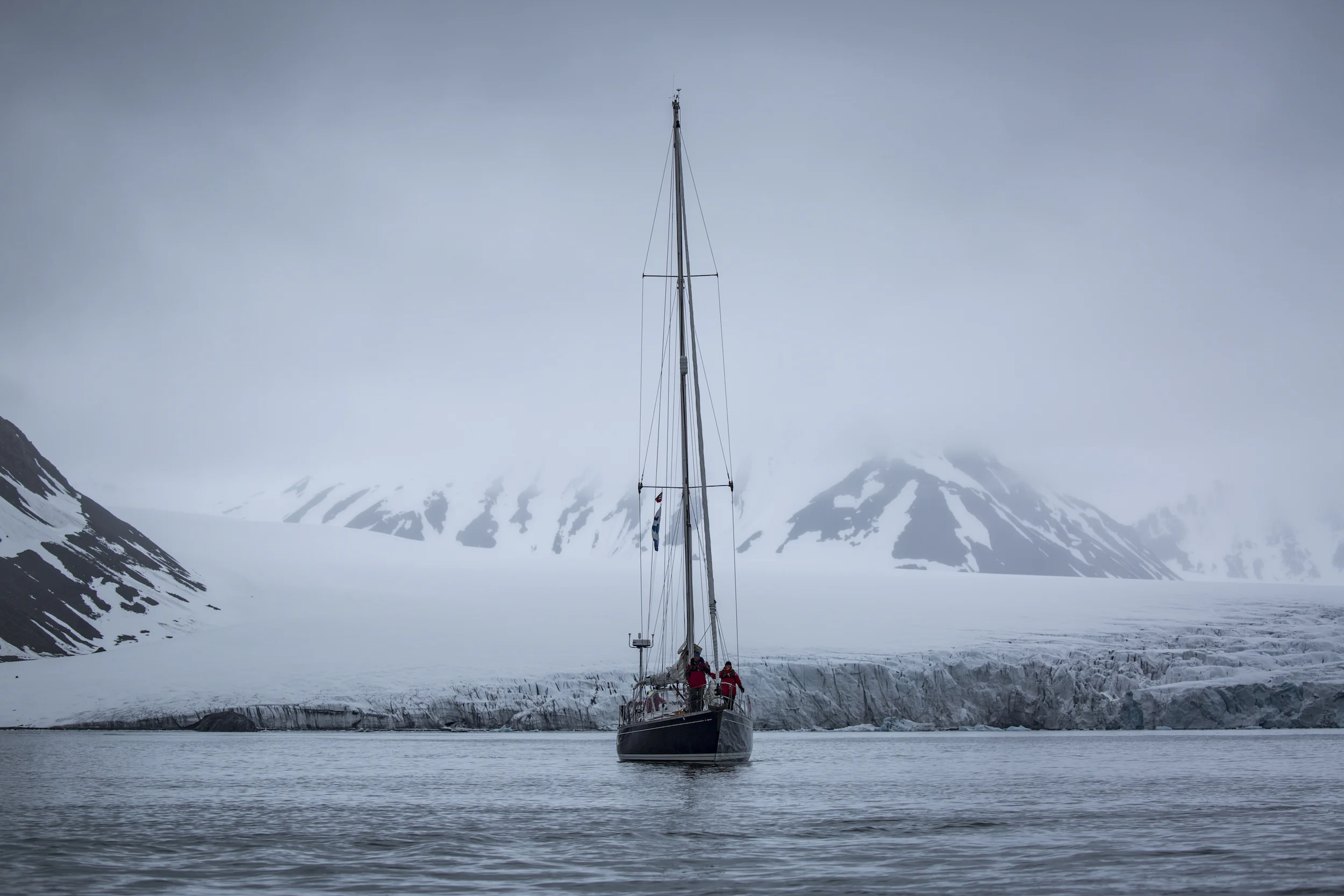Isbjorn & crew amongst the glaciers in Hornsund.
Our first night at anchor in Spitsbergen was spent right on the edge - had we had a westerly or northerly wind, it would have been untenable. But with the light easterly that blew cold air off the glacier, the anchorage was safe.
The crew spent the night on anchor watch. We stuck to the same rotation schedule we’d kept offshore. Except this time we only needed one person up in the cockpit at a time, so the 4-hour watches were split into 2-hour shifts. In reality, these anchor watches were spent at the nav station, with the occasional glance out the companionway to look around. I just wanted to make sure we didn’t let our guard down, as Isbjorn is probably in more danger inshore here than offshore.
Isbjorn spent much of the next morning on anchor in fog and snow showers. Visibility dropped to less than half a mile, and we could just barely make out the islands sheltering us from the open ocean beyond. The mountains and glaciers that were visible when we made landfall disappeared in the grey murk.
Snow on June 12! It's snowed almost every day here in Spitsbergen.
After lunch and a good rest (the captain, me, didn’t take anchor watches - instead, as at sea, being constantly on call), we weighed anchor and tacked south back towards Hornsund. The wind was light out of the south, and with the slight north-setting current, there was no chance of getting anywhere under sail, so we rolled in the genoa and motor-sailed along the coast, keeping a close lookout for glacial ice and wildlife. We got our first sense of the scale of this place - as we moseyed along at 5 knots, the scenery to our left just didn’t seem to change. The landscape here is so big, that at the meandering speeds of a sailing boat, you wind up looking at the same features for a long while.
Hansbreen Glacier, our first anchorage in Hornsund at 77º North.
As if on cue, as we entered the fjord, the weather began to break. The first patches of blue sky appeared overhead, and soon we could see sunshine on the massive ice fields at the far eastern end of the fjord. Isbjornhamna hove into view to port, the small Polish Polar Station (say that five times fast), with it’s few buildings and antennas, standing out amongst the natural features of the terrain. We’d had a general plan to explore this area of the fjord and nearby Hansbreen (‘Hans Glacier’). I’d eyed up an small anchorage called Kamavika at the tongue of the glacier as our destination.
We motored slowly up towards the glacier, having dropped the mainsail in the dying breeze 30 minutes beforehand. My curiosity and sense of awe overwhelmed any prior stress I had been feeling and for the first of what would happen on many occasions in the following 36 hours, I as a skipper new to the challenges of the north and the ice, had an ‘aha’ moment. On a millpond still bay, chunks of ice that had broken off the glacier floated harmlessly around the boat. We approached the largest of the bergs, a few hundred years from the glacier terminus itself, and only a boat-length from this mass of ice the most brilliant blue you can imagine, killed the engine. Isbjorn bobbed in the water with the iceberg. All else was quiet, save for the crew launching the inflatable for the first recce inshore in Spitsbergen.
We played in the shadow of the glacier for over an hour, flying the drone off the boat, sending the crew out in the dinghy to explore the ice, even collecting some of the smaller bits to save for a little rum toast later on. Time didn’t matter to us then, especially with the never-ending sunlight. It was late into the night until we got the anchor down in Kamavika and had dinner, but nobody cared. We joked we could simply reset the clocks to whatever the time felt like, ‘cause the daylight never changed, just the weather and the direction towards the sun.
The crew remained on anchor watch in Kamavika despite the calm conditions. In reality, we were on wildlife watch as much as danger watch. But, particularly anchored that close to the glacier, we were on ice watch in case any bergy bits floated in towards our anchorage. We could fend them off with the ice poles Ola had fashioned for us a lifetime ago in Bodo, or get up and move Isbjorn in a hurry if need be. No ice came into the bay that night, and nor did any polar bears or walrus. But the snow came, and by morning Isbjorn had an inch of fluffy white powder in the cockpit and coating all the winches and lines. James made a little snowman with raisins for buttons and an M&M for a mouth.
When I woke up, the sun was out and the snow had cleared. I was greeted by the surrounding scenery that the crew had been admiring through the night. The wind was calm, and while my captain senses hate leaving the boat unattended, I couldn’t resist going along for a mission to the glacier. The GRIBs showed stable, windless weather, and in any case, the boat would remain in sight the whole time. For the second time, my curiosity and pure joy of exploring overwhelmed any sense of fear or stress. I loaded up the rifle, the med kit, one survival suit (in case the dinghy was punctured - one of us could swim back to Isbjorn in the suit), and we headed ashore. Jordan was our dinghy captain, shuttling me, James and Steve ashore first with the rifle and the camera gear, then returning to collect Mia, Dave and Patty. We pulled the dinghy far up the beach in the snow and set out in the sunshine under the foot of the 3,000-foot peaks to the east, watching Isbjorn get smaller and smaller in her protected cove at Kamavika.
Isbjorn's crew approaches the terminus of the Hansbreen glacier ('breen' actually means glacier in Norwegian).
The glacier appeared only a short walk away. The reality was a 2-kilometer walk across varying terrain, a mix of snow, ice, mud and gravelly stone leftover from where the glacier had retreated. Not that long ago the bay Isbjorn was anchored in didn’t exist - it would have been covered by glacier.
James brought along ice axes which came in handy!
We made the ice face without much trouble and found a stable, gently sloping piece of ice we could safely climb onto. James had brought along two ice axes just for these occasions, and we hauled ourselves from the dirty, muddy slopes onto the pure white of the freshly fallen snow on top of the millennia-years old ice. Our corner of the glacier was on it’s far eastern flank, forced up into towering, irregular ice chunks as the weight of the entire thing came to bear on this particular spot. To the north and west, the glacier kept a much more regular appearance - only here, where the stresses were highest, did we get the incredible geometries. From here, the glacier face that disappeared into the sea looked to be maybe as high as Isbjorn’s mast, some 70-feet or so. James measured it from the drone at 150!
Andy & Mia on the Hansbreen glacier. The terminus at the water there was 150-feet high!


